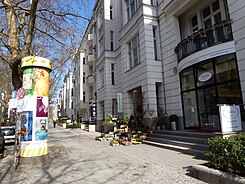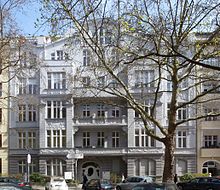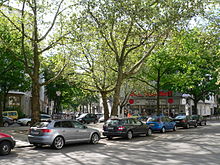Giesebrechtstrasse
| Giesebrechtstrasse | |
|---|---|
| Street in Berlin | |
| Giesebrechtstrasse on Kurfürstendamm | |
| Basic data | |
| place | Berlin |
| District | Charlottenburg |
| Created | around 1900 |
| Connecting roads | Wilmersdorfer Strasse , Kurfürstendamm |
| Cross streets | Sybelstrasse , Clausewitzstrasse |
| Places | Meyerinckplatz , Hindemithplatz |
| Numbering system | Horseshoe numbering |
| use | |
| User groups | Pedestrian traffic , bicycle traffic , motor traffic |
| Technical specifications | |
| Street length | 390 meters (including Meyerinckplatz ) |
The Giesebrechtstraße is a residential street in Berlin district Charlottenburg between the Wilmersdorferstraße and the Kurfürstendamm runs. It was created in the early 1900s in connection with the development of the Kurfürstendamm. Unlike most of the side streets on Kurfürstendamm, it does not branch off at right angles , but at an obtuse angle of around 120 degrees.
history
The development of this area in section V for southern Charlottenburg was already taken into account in the Hobrecht plan of 1862. An "upscale residential development" was planned, but this was not implemented. It was only with the plans for the construction of the Kurfürstendamm from 1882 that detailed development plans emerged for the area west of Leibnizstrasse , which were also implemented. The route is not yet shown on the map from 1893 , but it was already noted without a name in 1900. The development began in 1904, so that on August 20 it was named after the historian Wilhelm von Giesebrecht (1814–1889), matching the Mommsen , Niebuhr , Sybel , Dahlmann , Droysen , Waitz , Gervinus and Rankestrasse , which were also named after historians, as well as to other streets in this district that are named after scientists. The street was numbered according to the horseshoe principle .
In the Berlin address book from 1905, house numbers 1–23 are shown as a new building or construction site with the associated owners (master masons, carpenters and architects or Kurfürstendamm flooring company). Already in 1906 the numbers 6, 11-14 and 16-19 were registered as construction sites or new buildings, in 1907 only numbers 17 and 19; with which the development can be considered completed.
local residents
Since then, the street has developed into a residential area for the upper middle class , including a large proportion of Jewish residents. According to the address book, the military, civil servants, professors, lawyers, reindeer , architects, doctors, engineers, merchants, master craftsmen as well as servants (porters, gardeners) and several artists lived here.
Known residents were or are:
- Eduard Künneke , operetta composer and his daughter Evelyn Künneke , singer , dancer and actress , No. 5
- Fritz Olive , lawyer, writer, librettist , No. 11
- Ernst Kaltenbrunner , Head of the Reich Security Main Office , No. 12
- Wolf Vostell , painter , sculptor and happening artist , No. 12
- Joseph Wulf , German-Polish historian of Jewish origin and Holocaust survivor, No. 12
- Friedrich Wilhelm von Willisen , military, adviser to Heinrich Brüning , No. 15
- Edith Lorand , violinist, No. 13
- Stefan Lukschy , director and author, No. 13
- Paul von Hase , city commandant of Berlin 1940–1944, resistance fighter , No. 17
- Grethe Weiser , actress, No. 18
- Hubert von Meyerinck , actor, lived here with his mother, number 18
- Michael Naumann , former Minister of State for Culture
The street has remained an upscale residential area to this day, not least because of the size of the apartments. Numerous doctors, psychotherapists, lawyers and financial service providers have their business premises here, as well as the Horst Dietrich gallery and the Winter bookshop.
Buildings and places of note
Architectural monuments
The building ensemble Giesebrechtstrasse 5–8, 13–15 with the adjoining houses Clausewitzstrasse 9 and Sybelstrasse 64, located between Kurfürstendamm and Meyerinckplatz , was built between 1904 and 1906 and is now a group of tenement houses that is a protected “ensemble”. Buildings No. 3, No. 6 and No. 20 are listed as architectural monuments in the Berlin Monument List. The corner house at Giesebrechtstrasse 9 / Kurfürstendamm 63 was destroyed during the Second World War and replaced by a new building. The opposite corner building at Giesebrechtstrasse 10 / Kurfürstendamm 92 was also damaged, but could be rebuilt. The other houses remained largely undamaged.
Notable places
From the 1950s to the 1990s, there was the Wiener Stüber'l at Giesebrechtstrasse 3 , a wine tavern with an impressive interior that was often visited by celebrities and which had to close when its owner Friedrich Müller died. Today the Julep’s restaurant is located in the premises .
In 1922 the Muslims from 41 nations living in Berlin founded the Islamic Community Berlin e. V. The Indian imam Maulana Sadr-ud-Din from Lahore , an imam of the Ahmadijja-Andschuman-Ischat-i-Islam-Lahore movement, is considered to be the founder . In 1925 the community built the Wilmersdorfer Mosque on Brienner Straße .
The Rainer Werner Fassbinder Foundation, Gemeinnützige Nachlaßstiftung GmbH has its headquarters at Giesebrechtstrasse 7.
From the early 1930s on, at Giesebrechtstrasse 11, there was the Kitty Salon run by Kitty Schmidt , a noble brothel that was allegedly used for espionage purposes by Walter Schellenberg from the Reich Security Main Office from 1939 . The later head of the Reich Main Security Office (from January 1943), Ernst Kaltenbrunner , lived in the neighboring house No. 12.
From August 1967 to July 1968, Commune 2 lived in Giesebrechtstrasse 20 in a 7 1 ⁄ 2 room apartment.
In the traditional Café Richter directly on Hindemithplatz , various furnishings are reminiscent of the old days of coffee houses . It was considered a meeting place for the Charlottenburg scene . Several restaurants and a pub are also on the street.
Cinema the crank
In the years 1934/1935 the architect Karl Schienemann converted a former corner shop in house No. 4 for the operators Heinz Grabley and Hanna Koenke into the first pure sound film cinema in Berlin. The traditional cinema die crank opened in 1935 amid massive hostility from the owners of the nearby Minerva-Lichtspiele against the Jewish operators. In 1936 the cinema moved to Hanika, Paula Hitzigrath and Walter Jonigkeit . From 1940 to the beginning of the 1970s Jonigkeit ran the cinema alone, although it was rebuilt several times and served as an ammunition store at the end of the Second World War.
As early as May 27, 1945, the crank was one of the first Berlin cinemas to resume operations with Soviet films at six in the evening after the end of the war . The classic film Gone With the Wind has been shown here for 28 months since December 4, 1953 and has been shown on this date every year since. After Jonigkeit gave up the cinema in the 1970s, it served briefly as a sex cinema . From 1974 the Munich-based Studio Filmtheaterbetriebs GmbH & Co took over the cinema in order to operate it again as an art house cinema with a good reputation. From 1988 to 2003 the cinema belonged to UFA , which carried out a renovation with three cinemas of different sizes, but had to close it on June 25, 2003 with the 701st performance of Gone With the Wind .
From January 1, 2004, CH-Media GmbH tried to operate the cinema as a “one-dollar cinema”, but had to give up in February 2005. Since February 18, 2005, the Terra-Real Grundstücks-, Telekommunikations- und Filmtheater GmbH owned by Tom Zielinski has been operating the cinema, which was reopened in June 2005 as a premiere cinema with three movie theaters. After celebrating the 75th anniversary of the cinema in 2009, it finally came to an end on December 21, 2011, although a citizens' initiative “Save the Crank” with the prominent support of Beate Jensen , Rosa von Praunheim , Dieter Kosslick , Oliver Kalkofe and Angelica Domröse , Stefan Lukschy , Gerd Wameling , Peter Raue , Andrea Countess Bernstorff, Wim Wenders and others tried to prevent this. In the last sold-out performance, the film Gone with the Wind was shown again.
The cinema operator and owner of the property had decided to renovate the whole house and rent the rooms to an organic supermarket chain. The opening took place on April 25, 2013. The residents feared that the delivery would cause constant traffic jams and significantly damage the character of the street. The former Minister of State for Culture Michael Naumann , also a resident of the street, described the situation in an article in the Tagesspiegel . The association "Citizens for the Meyerinckplatz" was founded by committed citizens to counter this development.
Stumbling blocks

Since May 8, 2011, Giesebrechtstrasse has been the first street in Berlin where all former Jewish residents who were murdered by the National Socialists are honored with stumbling blocks . From 1941 to 1943, a total of 116 Jewish men, women and children were deported to concentration camps from the 22 houses on the 355-meter-long Giesebrechtstrasse . Stumbling blocks were set for 84 of them on May 8, 2011, on the day of liberation, 66 years after the end of the Nazi dictatorship. 32 stumbling blocks were set in the sidewalk earlier. The artist Gunter Demnig , initiator of the Stolpersteine project, himself laid the memorial stones donated by residents of Giesebrechtstrasse. Together with the Stolpersteine Charlottenburg-Wilmersdorf initiative, residents of Giesebrechtstrasse had prepared this campaign.
Film location
Because of the Wilhelminian style atmosphere, Giesebrechtstrasse is a popular location for filming scenes.
- In 1981 scenes for The Walker from Sans-Souci with Romy Schneider were filmed here.
- 2018 for my friend, the disgust with Dieter Hallervorden .
- In August 2019 for Wunderschön by Karoline Herfurth .
- In September 2019 for matzo, kebab and sauerkraut , culture clash comedy by Christoph Schnee .
See also
- List of cultural monuments in Berlin-Charlottenburg
- List of stumbling blocks in Berlin-Charlottenburg
- List of streets and squares in Berlin-Charlottenburg
literature
- Wolfgang Benz : Survival in the Third Reich: Jews in the Underground and their Helpers . CH Beck, 2003 ( books.google.de [accessed April 15, 2013]).
- Peter Wyden : Stella Goldschlag. A true story. Steidl, 2019
Web links
- Giesebrechtstrasse. In: Street name lexicon of the Luisenstädtischer Bildungsverein (near Kaupert )
- Reinhard Naumann: From Henriettenplatz to George-Grosz-Platz . 107. Walk in the neighborhood on November 13, 2010. BA Charlottenburg-Wilmersdorf.
Individual evidence
- ↑ Giesebrechtstrasse . In: Berliner Adreßbuch , 1905, Part 5, Charlottenburg, p. 47.
- ↑ Wolfgang Benz , Barbara Distel (ed.): The place of terror . Vol. 3. Sachsenhausen, Buchenwald
- ↑ Haus in Berlin, estate ( Memento of the original from March 5, 2016 in the Internet Archive ) Info: The archive link was automatically inserted and not yet checked. Please check the original and archive link according to the instructions and then remove this notice.
- ^ Gallery Horst Dietrich
- ↑ Winter bookstore
- ↑ Ensemble Giesebrechtstrasse 5–8, 13–15
- ↑ Giesebrechtstrasse 3
- ↑ Giesebrechtstrasse 6
- ↑ Giesebrechtstrasse 20
- ↑ Helmut Zenz: History of Islam in Germany from 1731/1732 to 1945. (No longer available online.) 2003, archived from the original on November 5, 2012 ; Retrieved April 15, 2013 . Info: The archive link was inserted automatically and has not yet been checked. Please check the original and archive link according to the instructions and then remove this notice.
- ↑ Rainer Werner Fassbinder Foundation ( Memento of the original from May 20, 2013 in the Internet Archive ) Info: The archive link was inserted automatically and has not yet been checked. Please check the original and archive link according to the instructions and then remove this notice.
- ↑ Hanna Huhtasaari: Nazi brothel: seducing for the "Führer". In: Der Spiegel , one day. August 27, 2008, accessed April 15, 2013 .
- ^ Sven Felix Kellerhoff: "Salon Kitty" - the reality of the Gestapo brothel. In: Welt Online , December 10, 2013.
- ↑ Werner Kahl: Beware of firearms !: Communist extremism, terror and revolutionary violence . Olzog, Munich, ISBN 978-3-7892-7280-6 , p. 55.
- ↑ The crank at allekinos.com
- ↑ Save the crank
- ↑ Andreas Conrad: Another cinema is disappearing in the old west. In: Der Tagesspiegel . October 18, 2011, accessed April 15, 2013 .
- ↑ Michael Naumann: A small local destruction. In: Der Tagesspiegel. March 20, 2013, accessed April 15, 2013 .
- ↑ Photos from the relocation on May 8, 2011
- ^ Stumbling blocks in Charlottenburg-Wilmersdorf . District lexicon on berlin.de
- ↑ Giesebrechtstrasse. District Office Charlottenburg-Wilmersdorf of Berlin, accessed on April 15, 2013 .
- ↑ Süddeutsche Zeitung, June 29, 2019
- ^ A taboo in Holocaust research . In: Der Spiegel , November 2, 1992
Coordinates: 52 ° 30 ′ 7.7 ″ N , 13 ° 18 ′ 34.6 ″ E




